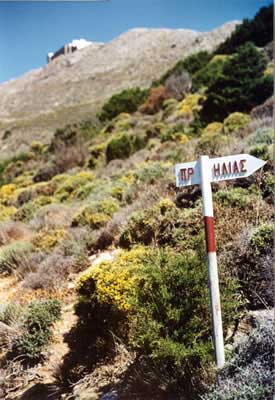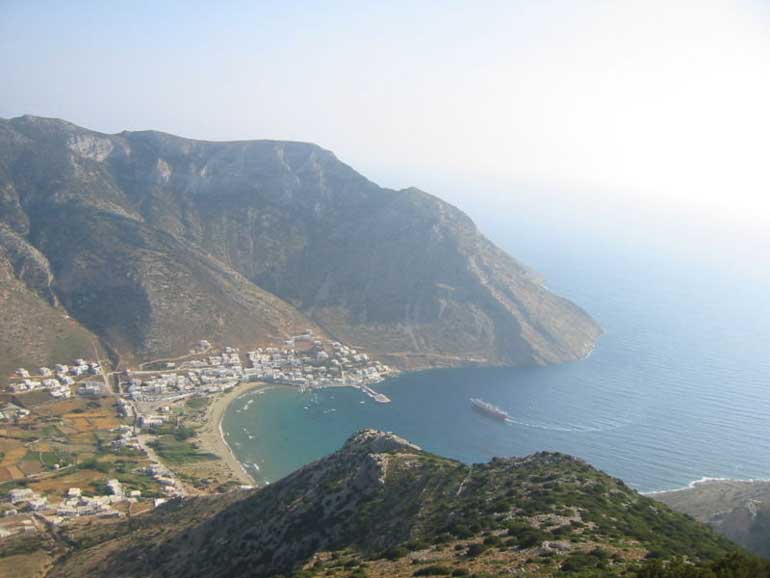.
Sifnos (Greek: Σίφνος; the spelling Siphnos is obsolete in English but still by convention often used to refer to the island in ancient times) is an island municipality in the Cyclades island group in Greece. The main town, near the center, is known as Apollonia (pop. 942) home of the island's folklore museum and library. The town's name is thought to come from an ancient temple of Apollo on the site of the church of Panayia Yeraniofora. The second-largest town is Artemonas (744), thought to be named after an ancient temple of Apollo's sister-goddess Artemis, located at the site of the church of Panayia Kokhi. The village of Kastro (101), built on top of a high cliff on the island's northwestern shore on the site of the ancient city of Siphnos, today has extensive medieval remains and is the location of the island's archeological museum. The port settlement, on the west coast of the island is known as Kamares (188).[1]

Geography
Sifnos lies in the Cyclades between Serifos and Milos, west of Delos and Paros, about 130 km (80 nautical miles) from Piraeus (Athens' port). It has an area of 74 km² and is 15 km long and 7.5 km wide. and a shoreline of 70 km, with a permanent population of 2442. The island is reached on the ferries which run on the Piraeus- Kythnos- Serifos- Sifnos- Milos- Kimolos line. There are also infrequent sailings to other islands in the Cyclades.

Profitis Ilias
History
Sifnos was inhabited by human beings from at least 4000 BCE.[2] Archeological evidence indicates the island was within the mainstream of Late Neolithic and Early Bronze Age Cycladic civilization. The island was very wealthy in ancient times, thanks to its gold, silver, and lead, which were being mined there as early as the 3rd millennium BCE.[3] Proof of this is the treasury which the Siphnians built at Delphi in the 6th century BCE to house their offerings. According to Pausanias, these mines were obliterated by floods in ancient times, a disaster which some attributed to the people of the island suspending their tribute out of greed.[4][5] Modern scholars suggest that some of the mines flooded because they had eventually been dug to a depth below sea level,[6] while the majority of them, situated far from the sea, were probably exhausted.[7] Remains of ancient mines, some dating back to prehistoric times, are still to be seen on the island, most notably at Ay. Sostis, and remains of ancient fortifications, dating from the third millennium to the sixth century BCE, have been found at Ay. Andreas, Ay. Nikitas, and Kastro.[8] Another indication of Sifnos's wealth is the fact that it was one of the first places in Greece to mint coins, beginning around 600 BCE, although the number minted does not seem to have been great, and the island of Aegina, which used Siphnian silver, seems to have developed a much greater export capacity in this form of the metal.[9]
During the extensive Greek migrations which occurred beginning perhaps as early as the 12th century BCE, Sifnos was mostly populated by Ionian Greeks from Athens. The island appears only rarely in the subsequent ancient history of Greece. In the sixth century BCE it was invaded by pirates from Samos. In the fifth century BCE, Sifnos was an official member of the Greek defensive alliance formed to fight the Persian Wars. In the next century the island was briefly taken over by the Persians but liberated by a fleet sent by Alexander the Great.[10]
Little is known of Sifnos during the Roman and Byzantine eras, though three Roman sarcophagi remaining in the streets of Kastro and a collection of 80 Byzantine coins in the Museum there testify to substantial continued population during those times. In the early 14th century Sifnos came under the power of the Italian or Spanish Hospitaller Januli da Corogna, who proclaimed the island independent from the Sanudi dynasty which then ruled most of the Cyclades area. The Corognas ruled Sifnos for over a hundred years; around 1440 as a result of a dynastic marriage power over the island passed to a Bolognese family, the Gozzadini, who ruled until 1617. Though both these dynasties became thoroughly Hellenized, they retained their Roman Catholic form of religion.[11]
Little is also known of Sifnos during the Ottoman rule of the Cyclades from 1537 on. It seems likely that, as in most of the Cyclades, Ottoman rule on Sifnos was fairly loose, consisting mainly of the collection of taxes, with the islanders largely administering their own affairs. By the early 17th century Sifnos was a significant commercial center, and from 1821 the island played an important role in the Greek national revolution.[12]


Platys Gyalos
Bay of Kamares
Notable figures from Sifnos in modern times include the educator and revolutionary leader Nikolaos Chrysogelos (1780–1858), who served as Greece's Minister of Education, and the chef Nikolaos Tselementes (1878–1958), who wrote a classic cookery book still used in Greece today.[13] The island's rich clay veins, sunny weather and temperature have made Sifnos a capital of pottery in the Aegean, with unique jars and pots that are a kind of "trademark" of the island. They are frequent the Sifnian everyday life, such as ashtrays, cooking and food vessels, "masteles", "foufoudes" (kind of chimneys) etc. Locally, 'Sifnios' was a variant word for potter. Initially the oldest potteries were found in central regions such as Artemon and Ano Petali to avoid pirate attacks.
Historical population
Year Population
1991 1,960
2001 2,442
Subdivisions
The municipality Sifnos is subdivided into the following districts and villages:
Apollonia (Apollonia, Vathy, Kamares, Kastro, Kato Petali, Platys Gialos, Faros, Chrysopigi)
Artemonas (Artemonas, Agia Marina, Troulaki, Cherronisos)
Gallery
See also
Communities of the Cyclades
References
^ Barber, Robin, Blue Guide Greece. 6th ed., London, A & C Black, 1995, p. 665
^ Maranti, Anna Siphnos: The Brillance of Apollo. Athens, Toubis, 2002, p. 18
^ Fitton, J. Lesley, Cycladic Art, London, British Museum, 1989, p. 13, 57.
^ Herodotus III.57
^ Pausanias X.11
^ Bury, J. D. and Meiggs, Russell, A History of Greece to the Death of Alexander the Great. 4th ed., New York, St. Martin's Press, 1978, p. 135
^ Some Aspects of Lead and Silver Mining in the Aegean, VII
^ Barber pp. 665-666.
^ Maranti p. 20.
^ Hammond, N. G. L., A History of Greece to 322 bc, Oxford, Oxford University Press, 1967, pp. 82, 88, 199, 226, 608.
^ Hetherington, Paul, The Greek Islands: Guide to the Byzantine and Medieval Buildings and their Art. London, Quiller, 2001, pp. 301-302
^ Maranti pp. 27-28
^ Maranti p. 34, 42.
| Ancient Greece
Science, Technology , Medicine , Warfare, , Biographies , Life , Cities/Places/Maps , Arts , Literature , Philosophy ,Olympics, Mythology , History , Images Medieval Greece / Byzantine Empire Science, Technology, Arts, , Warfare , Literature, Biographies, Icons, History Modern Greece Cities, Islands, Regions, Fauna/Flora ,Biographies , History , Warfare, Science/Technology, Literature, Music , Arts , Film/Actors , Sport , Fashion --- |
Retrieved from "http://en.wikipedia.org/"
All text is available under the terms of the GNU Free Documentation License


